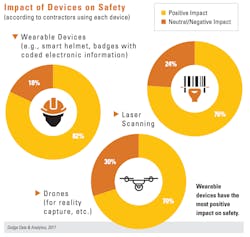The State of Construction Safety
Technology is changing the face of safety management as well as practices on the job site, but the human element of toolbox talks still resonates.
These are among the conclusions of a comprehensive study from Dodge Data & Analytics, called “Safety Management in the Construction Industry,” executed with help from United Rentals and the Center for Construction Research and Training.
It’s the third in a series (2012, 2015) designed to examine the impacts of a wide variety of safety-related practices, as well as “changes in means and methods of safety training and communication.”
Here are some of the key findings relatable to equipment owners and contractors.
Safety’s impact on projects
Since the 2012 study, it’s been clear that contractors experience important benefits from their safety investments. There are the core benefits, such as effects on budget, schedule, and quality (right), but there are also business benefits, like improved standing in the industry and the ability to contract new work. These were reported by the majority of contractors participating in the study.
Practices used
Policies and organizational practices most commonly used by responding contractors include maintaining an open-door policy to workers to report hazards (86 percent), including job-site workers in the safety process (82 percent), site-specific safety and health plans (80 percent), and site-specific programs for all employees and subcontractors (73 percent).
Key for many Construction Equipment readers are the less common practices found to promote safety, which include conducting job hazard analysis/job safety analysis before a project starts, carrying out thorough near-miss and incident investigations, having measurable safety goals and objectives, and prequalifying subcontractors based on safety performance. With these, the study found a big gap in their use between large contractors (defined as those with 500 or more employees) who do use the practices, and small ones (particularly those with less than 20 employees), who often do not.
The study points out that this gap highlights the need in the industry to encourage or incentivize smaller contractors to engage in the practices.
Contractors are motivated by concern for workers. The highest percentage (82 percent), and this has remained consistent since 2012, report they engage in programs out of concern for worker health and safety. Next comes a combination of liability and insurance costs, tallying 68 percent for both. Further, 75 percent specifically say that reduced insurance rates would encourage them to increase their investment in safety.
Training and communication
Toolbox talks continue to be the most effective means of communication with workers on safety, whether to communicate safety messages or to provide information on safer equipment, materials, and processes. Training programs are also widely used and considered to be effective, but other means, including seminars and meetings, emails or videos, are sometimes ranked first as effective communications tools.
Drilling down to explore the top means of providing safety information, toolbox talks still comes out on top, no doubt for the personal touch. Emails and videos fall in the middle, and resources such as websites, trade publications, and webinars fare rather poorly.
Technology: mobile tools
Safety inspection and GPS/mapping apps are used by 42 percent and 41 percent, respectively.
Technology: emerging tools
It’s no surprise that drones are the most widely used of what the study terms emerging technologies for safety purposes (the category also includes laser scanning, wearable devices such as smart helmets and badges with coded electronic information, robotics, photogrammetry, and optical head-mounted displays like Google Glass and Microsoft Hololens). Some 21 percent of respondents are using drones for “reality capture.”
Wearable devices are used by 13 percent currently, with 21 percent of those users being large contractors. Laser scanning is used by more contractors than photogrammetry, by a 10-percent margin. Although the study points out that both are means of capturing existing conditions electronically, laser scanning is highly accurate, yet far more expensive than photogrammetry. The study’s authors say that with the increasing use of cameras on job sites, it will be interesting to see whether or not photogrammetry sees increased use as well.
The study also asked contractors using emerging devices about their impact on safety.
A high percentage, 82 percent, report that wearable devices have a positive impact on safety. Laser scanning was cited by 76 percent, and drones by 70 percent. Although some respondents reported these devices had a neutral or negative impact, all findings seem to point to wider adoption of the technologies as the majority of those users report a positive impact on safety.


